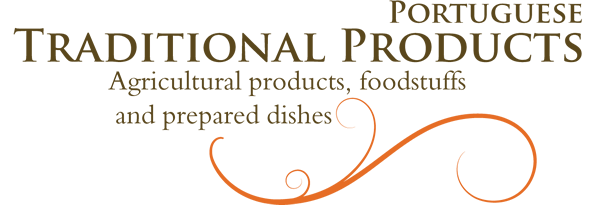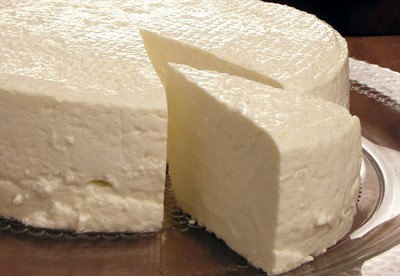Tags: Autonomous region of Madeira • PGI - Protected Geographical Indication (Agricultural products and foodstuffs) • Agrupamento do Requeijão Madeirense
Description: Requeijão da Madeira is the fresh dairy product, resulting from the heat coagulation of whole cow's milk, acidified naturally by native lactic bacteria developed in raw milk, without addition of any rennet, yeast or acidifier, only added of salt and not subjected to any curing process, following the traditional way of produc-tion in Madeira Island.
Requeijão da Madeira it´s presented as a fresh product whose mass, not pressed, can be molded in cotton towels to form a “bread” or “ball” locally called “pão de requeijão”, which can have several kilograms of weight (less than 10 kg) and are packed in sealed plastic bags.
It can also be self-moulded in moulds or multi-mold plates for draining the “sorelho” and later packaging in individual packages of different capacities (between 100 g and 500 g), also sealed.
Requeijão da Madeira it´s presented as a fresh product whose mass, not pressed, can be molded in cotton towels to form a “bread” or “ball” locally called “pão de requeijão”, which can have several kilograms of weight (less than 10 kg) and are packed in sealed plastic bags.
It can also be self-moulded in moulds or multi-mold plates for draining the “sorelho” and later packaging in individual packages of different capacities (between 100 g and 500 g), also sealed.
Requeijão da Madeira has an intense or a somewhat pale colour, ranging from chalky white to slightly yellow.
Its consistency is creamy, smooth to more or less crumbly and dense or may contain some cracks or cavities. It is usually quite firm, which allows it to be cut for packaging, but when automolded into casts or in multi-mold boards (for individual packaging), it can remain wetter and less firm. It has a weak to medium cohesiveness, adhesiveness and hardness and a normal chewiness and elasticity.
It has a milky to buttery aroma, with sweet and fruity notes. Its flavour is also milky and pleas-ant, slightly buttery and/or sweet, with a normal salty and slightly acidic taste. Both aroma and flavour have a normal intensity.
Its consistency is creamy, smooth to more or less crumbly and dense or may contain some cracks or cavities. It is usually quite firm, which allows it to be cut for packaging, but when automolded into casts or in multi-mold boards (for individual packaging), it can remain wetter and less firm. It has a weak to medium cohesiveness, adhesiveness and hardness and a normal chewiness and elasticity.
It has a milky to buttery aroma, with sweet and fruity notes. Its flavour is also milky and pleas-ant, slightly buttery and/or sweet, with a normal salty and slightly acidic taste. Both aroma and flavour have a normal intensity.
Production method:In Requeijão da Madeira production, the main raw material is raw cow's milk produced in dairy farms from Madeira island. Holstein-Friesian is the most used breed, for cow's milk production.
The natural acidification process, in Requeijão da Madeira production, can occur: by the natural evolution of raw milk preserved in refrigerated tanks, at required temperatures (below 4 ºC), for more than 24 hours, or by the use of self-produced yeast, from natural acidification of a small portion of raw cow's milk which, for a few hours, is kept at room temperatures (between 20 ºC and 25 ºC) in protected and controlled conditions, allowing the development of native strains of lactic bacteria (which multiply quickly in these conditions) transform-ing lactose into lactic acid. This acidified milk is added to fresh raw milk to be processed. In both cases, the objective is to reduce pH of raw milk (with pH from 6.6 to 6.8) to a pH of 6.0 to 6.2, that is considered optimal for beginning of the cooking process that will lead to all milk proteins coagulation. This acid/heat coagulation process requires a lower acidification to initiate the precipitation of casein, and the progressive heat treatment, until it exceeds 85 ºC, promotes the total denaturation of the whey proteins, which coagulate together with the casein. Thus, casein and whey proteins are recovered in the rennet flakes that float on the surface of the sores and which are collected and poured into recipients lined with cotton towels to form the “wraps” that, after being pressed, give rise to the “breads” of “requeijão” or they are spread in moulds or multi-mold plates that are left to drain for the drainage of a large part of the sorelho and the self-moulding of the different individual forms of presentation of the Requeijão da Madeira.
Special features: This traditional method of transformation of the whole cow's milk, produced on the Madeira Island, determines that Requeijão da Madeira has all the organoleptic characteristic that distinguish it and that give it the fresh, slightly acidic (pH between 5.6 and 6.2), buttery and fruity aroma and flavour, which are much appreciated in its “natural” tasting preserves most of the constituents of the milk that gives rise to it, which determines its high content in proteins (normally greater than 15%), lipids (above 16%), ash (above 1.8%), while still maintaining some sugars (between 2% and 3%), these values can fluctuate throughout the year depending on natural variations, on composition of the raw cow's milk from Madeira island, from which is obtained; has, in addition to casein, high concentrations of whey proteins that give it high humidity properties (between 52% and 66%), good cohesiveness and low melting capacity that make it ideal in the cut for tasting “a natural” and in the production of the main delicacies of the conventual and contemporary Madeiran pastry.
Requeijão da Madeira has a salt content between 0.2% and 0.3% sodium.
Requeijão da Madeira has a salt content between 0.2% and 0.3% sodium.
Production area: All stages of production, from the obtaining the raw cow's milk, to its transformation into Requeijão da Madeira and its packaging, take place on Madeira Island.
History: Current producers of Requeijão da Madeira indicate that, since the beginning of the 20th century, at the high areas of Santo Antonio de Serra, Camacha and Gaula, their ancestors maintained, simultaneously with the butter production, the artisan production of un uncured cheeses, following elementary techniques maintained for centuries by cow farmers and by some Milkmen (raw milk distributors) of these localities, as a way of using the milk or “whey” that acidified in their transport and collection vessels.
Initially it was produced from the "whey" resulting from the milk that farmer taken to the skimming stations for the removal of the cream, that later was sent for the manufacture of butter, given that the breeders had the right to keep this product that had quality to be used in human or animal food.
This “whey” that, in fact, corresponded to skimmed milk, maintaining all the proteins and other raw milk components, naturally ended up acidifying in their vessels, so to have some use, many producers began to promote its “boiling”, collecting the clots formed, which compressed in a cotton towels to form small balls or “requeijão breads”, which they could then conserve and consume for a longer period.
Because it was initially produced from the, then called, “whey”, local producers started to call their production “Requeijão” which, later, in the second half of the 20th century, was successively called “Requeijão Madeirense” and «Requeijão da Madeira» to distinguish it from “Requeijão” from others origins, that are actually produced with the real whey resulting from the production of different types of cheese.
In recent years, Requeijão da Madeira, has gained great notoriety among Chefs, journalists and scholars of traditional Madeiran gastronomy and ethnography, who seek to know better this dairy product that they discovered is not only much more than a “Requeijão” (a whey cheese), but it is also much more what a cheese.
Producer Group
Agrupamento do Requeijão Madeirense
Agrupamento do Requeijão Madeirense
Control and Certification Body
CTAC-RAM - Comissão Técnica de Avaliação da Conformidade dos Produtos Agrícolas e dos Géneros Alimentícios da Região Autónoma da Madeira
CTAC-RAM - Comissão Técnica de Avaliação da Conformidade dos Produtos Agrícolas e dos Géneros Alimentícios da Região Autónoma da Madeira
Publication in EU official journal
JOUE L 2512 de 15.11.2023
Publication in the portuguese official journal
Aviso n.º 29/2022/M de 17.06.2022
Aviso n.º 35/2021/M de 01.09.2021
Portaria n.º 494/2019 de 14.08.2019
JOUE L 2512 de 15.11.2023
Publication in the portuguese official journal
Aviso n.º 29/2022/M de 17.06.2022
Aviso n.º 35/2021/M de 01.09.2021
Portaria n.º 494/2019 de 14.08.2019



